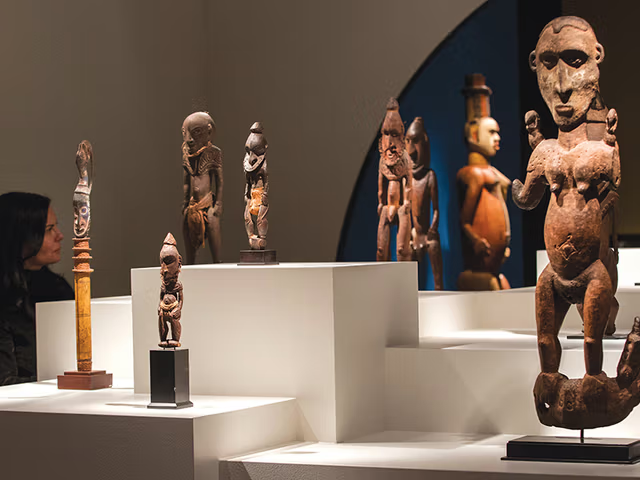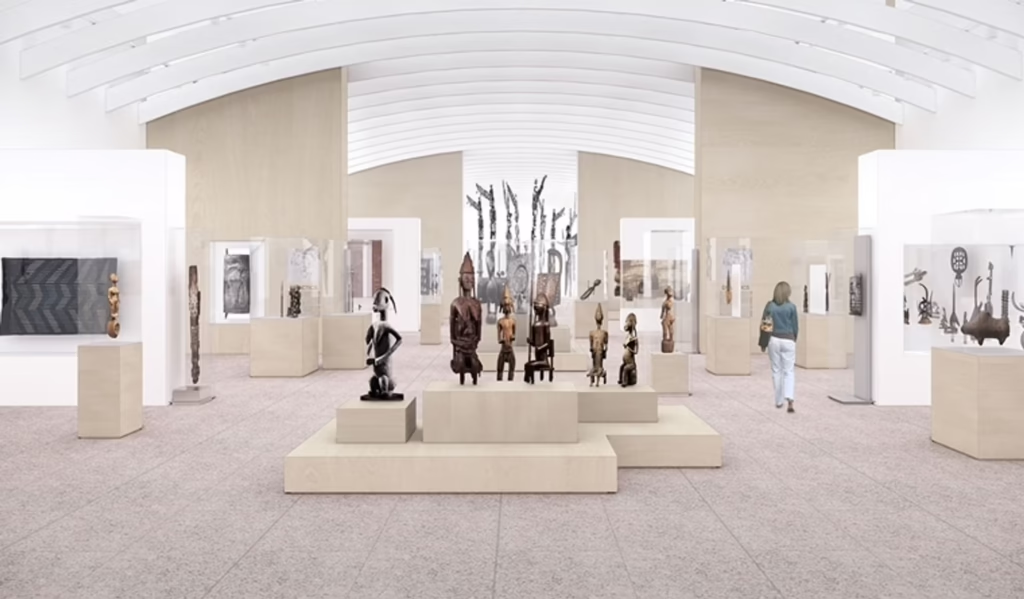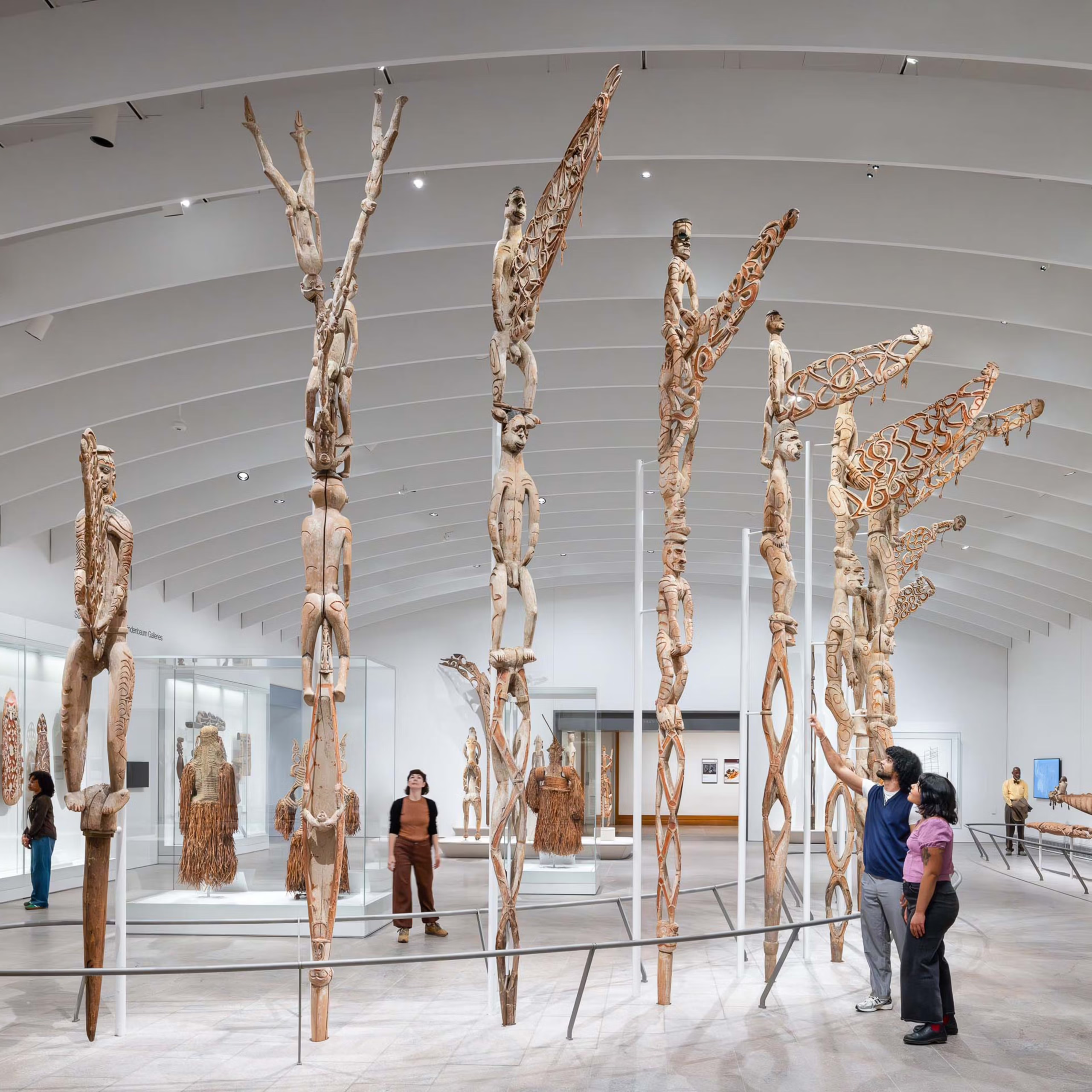A Celebration on Fifth Avenue, African Art in a New Light
On May 31, 2025, after a multi-year closure and extensive renovation, the Metropolitan Museum of Art in New York opened the doors to its galleries for African art in the Michael C. Rockefeller Wing. The celebratory reopening marked the conclusion of an ambitious project that had been ongoing since 2021 and incurred costs of $70 million. Max Hollein, the Austrian-born director of The Met, described this moment as an occasion for “great joy” and a celebration of “art traditions from around the world coming together in New York.” The ribbon-cutting ceremony kicked off a day-long festival that invited the general public to discover the newly designed wing and appreciate the artistic diversity of Africa, the Ancient Americas, and Oceania through a variety of programs for all ages, cultural performances, film screenings, and artist demonstrations.
The significance of this event extends far beyond the museum walls and is to be understood as a strategic cultural and civic statement. The emphatic support from New York City officials, including Cultural Affairs Commissioner Laurie Cumbo and various council members, underscores that this renovation is seen not just as a museum endeavor but as a significant cultural investment for the metropolis. The substantial sum of $70 million and the temporal coincidence with the celebrations of New York City’s 400th anniversary in 2025 illustrate how this project is embedded in the city’s cultural self-representation and economic vitality, aiming to solidify New York’s status as a global cultural center. The stated goal of giving the arts of Africa, the Ancient Americas, and Oceania their “rightful place in the global narrative of human creativity” also reflects an institutional evolution. It is a response to long-standing criticism of the representation of non-Western art and a sign that The Met views the renovation as an opportunity to implement a more equitable and contemporary presentation strategy – a change driven by both internal curatorial developments and external societal expectations for greater cultural equality in leading art institutions.

The Architecture of Empathy, Kulapat Yantrasast’s Vision for the Rockefeller Wing
The comprehensive redesign of the nearly 3,700 square meter (over 40,000 square feet) exhibition space was led by architect Kulapat Yantrasast, founder of WHY Architecture, who worked in close collaboration with Beyer Blinder Belle Architects LLP and The Met’s Design Department. Yantrasast’s design philosophy for the wing aims to create “true places of empathy” – spaces where visitors can authentically encounter and appreciate artworks from diverse world cultures. His approach, which he describes as “cultural Pad Thai,” combines multiple perspectives into something unique and accessible.
Key architectural innovations in the African art galleries include an imposing ceiling structure with a series of horizontal baffles reminiscent of the ribbed structure of the famous Great Mosque of Djenné in Mali, a UNESCO World Heritage site, thus creating a direct architectural homage to a significant African cultural monument. Another innovation is the integration of a custom-designed, sloped glass wall on the south facade, which allows filtered daylight into the rooms and creates a visual connection to the adjacent Central Park. This is intended to enhance the visitor experience and counteract the previous, more enclosed atmosphere. Yantrasast aimed to free the wing from its former character, which he described as “basement-like” , by introducing architectural elements such as arches and vaults that create continuity with other representative areas of The Met. The overarching goal of this transformation was to radically redefine the visitor experience, including through the use of innovative exhibition technologies, the development of new narrative approaches, and the enrichment of the contextualization of artworks through digital tools and thoughtful design.
Yantrasast’s architectural decisions are therefore not purely aesthetic but are conscious attempts to create an environment that honors the origin of the artworks while making them accessible and resonant for a diverse, contemporary audience. The architecture itself becomes an active participant in the process of cultural interpretation, aiming to foster a more respectful and less alienating encounter with the art. The realization of this ambitious vision was inextricably linked to the substantial financial investment of $70 million. This budget allowed not only for cosmetic adjustments but for a profound architectural and curatorial rethinking that permitted a fundamental transformation of the presentation and experience of these collections.

The Collection in New Splendor, Curatorial Realignment and Artistic Voices
The newly installed African art galleries present around 500 works from The Met’s collection of sub-Saharan African art. The selection spans a broad historical arc, from medieval masterpieces like a 12th-century terracotta figure from the Inland Niger Delta in Mali to contemporary creations such as Abdoulaye Konaté’s textile work Bleu no. 1 from 2014. A significant portion of the exhibited works – figures vary between one-fourth and one-third are new acquisitions, many of them gifts made in honor of the capital project, now on public display at The Met for the first time. Among these is a major promised gift of photographs from the Artur Walther Collection, which includes works by artists such as Samuel Fosso (whose 2008 series “African Spirits”), Seydou Keïta, and Zanele Muholi.
A central curatorial shift is the new emphasis on authorship. The reinstallation actively brings the individual artists behind the works to the forefront, presenting biographies and contextual information for around 40 recognized masters, from historical figures like the Yoruba sculptor Ọlọ́wẹ̀ of Ìsẹ̀ (ca. 1873–1938) to contemporary artists. This approach represents an important step away from the historically prevalent practice of presenting African art anonymously or merely as “tribal art,” and instead honors individual artistic creativity and identity. The arts of Africa, the Ancient Americas, and Oceania are presented as distinct traditions, with the new African art galleries strategically adjoining those for Greek, Roman, and European art to foster dialogue and highlight Africa’s ancient visual traditions and deep historical connections to other world cultures.
The reinstallation is based on eight years of research and intensive collaboration with an international network of experts, including scholars from the US and sub-Saharan Africa. Advisors to the project included renowned academics such as Professor Kwame Anthony Appiah, Professor Mamadou Diouf, and Professor Jacob K. Olupona, whose perspective that “the objects must act as springboards, bringing to life the ideas and belief systems” illustrates the new interpretive goals. Digital initiatives play a crucial role in enhanced contextualization: an animated map at the entrance to the Africa galleries provides an overview of regional polities, trade networks, and population movements that shaped cultural centers on the continent from 150,000 BCE to the present day.
A series of short films, produced with Ethiopian-American filmmaker Sosena Solomon in partnership with the World Monuments Fund (WMF), showcases prominent African cultural sites such as the rock-hewn churches of Lalibela or the Great Mosque of Djenné. These films are available in the galleries and online, bridging the gap between the museum objects and their original contexts. The new installation also strives to make the creative expertise of female artists more visible, particularly in media such as ceramics, textile dyeing, beadwork, and basketry. The first special exhibition in the wing’s new “In-Focus” gallery, Iba N’Diaye: Between Latitude and Longitude, is dedicated to the Senegalese modernist painter Iba N’Diaye (1928–2008) and contextualizes the gift of his masterpiece Tabaski to The Met.
This curatorial paradigm shift towards an art historical framing and inclusivity signals a departure from primarily ethnographic presentations. Instead, art historical narratives are emphasized, individual artistic achievements are honored, and diverse voices, particularly from African scholars, are included, underscoring Director Hollein’s ambition to “continually expand and even complexify narratives.” The sophisticated integration of digital media is more than a technological upgrade; it represents a vital educational strategy to reconnect the often decontextualized artifacts with their rich, distant original environment, history, and cultural significance. Such major projects often also act as catalysts for collection growth and refinement. The significant number of new acquisitions and important gifts was likely spurred by the renovation itself, as such undertakings offer a high-profile platform that encourages donors and facilitates strategic collection development.

Echoes of History, The Legacy of the Rockefeller Wing and the Debate over Interpretive Authority
The Michael C. Rockefeller Wing, which opened in 1982 to house Nelson A. Rockefeller’s extensive collection of non-Western art gifted to The Met in 1969, carries a complex history. It is named after Nelson Rockefeller’s son Michael, an ethnographer and collector who tragically disappeared in 1961 during a collecting expedition in New Guinea. The renovation and reopening inevitably bring sensitive ethical questions to the fore: debates about decolonization, the provenance of objects, and potential restitutions are gaining traction, particularly given the historical context in which many Western museums acquired non-Western art, and Nelson Rockefeller’s own controversial political and business activities in Latin America.
Critical voices, such as Professor Cruz Garcia from Iowa State University and Columbia GSAPP, view institutions like The Met as entities that “sanitize power” and “rebrand loot as patrimony”; the Rockefeller family is emblematic of this “machinery.” Garcia points to Nelson Rockefeller’s problematic tenure as Coordinator of Inter-American Affairs and as head of the International Basic Economy Corporation (IBEC), which was associated with negative environmental and social consequences in Latin America. Alisa LaGamma, curator of African art at The Met, counters such criticisms by stating that a large part of The Met’s African art collection was “essentially formed following independence in many of what were new nations across sub-Saharan Africa” and therefore “doesn’t necessarily have the heavy weight of a collection that was formed under colonialism.”
The Met emphasizes its proactive approach to these complex issues through a collaborative methodology, ongoing dialogue with international experts and scholars from origin communities, and the development of new, more nuanced narratives. A concrete example of this commitment is the collaboration with the Nigerian National Commission of Museums and Monuments (NCMM) on a documentation and education initiative.
There is an undeniable conflict between The Met’s narrative of reform and progress and the fundamental critiques of its colonial foundations. While the museum presents the renovation as a progressive step, critical scholars like Garcia argue that such efforts do not change the fundamental colonial logic of these institutions. This tension is central to understanding the reception of the reopening. The debates surrounding this specific wing are emblematic of broader, global discussions about the ethics of museum collections and demands for restitution. The name of the wing itself, “Michael C. Rockefeller Wing” , carries complex historical weight, as it commemorates an individual who collected artifacts within the context of colonial power dynamics. This direct association with the collecting practices of that era subtly reinforces the ethical questions raised by critics, regardless of the specific provenance of individual objects in the Africa galleries.

Cultural Resonance, Impact on New York, the Global Art Scene, and Beyond
The reopening is a key cultural event for New York City, significantly coinciding with the city’s 400th anniversary and underscoring The Met’s role in the global art center. New York City officials, such as Cultural Affairs Commissioner Laurie Cumbo, expressed the city’s pride in the project and praised the “enormous care, thoughtfulness, and collaboration” invested in the redesign of the galleries. Socially, the hope is for deeper public understanding and greater appreciation of African cultures and artistic traditions. Alisa LaGamma emphasized that these traditions represent the heritage of a significant and diverse segment of New York’s population. Although not explicitly quantified, positive economic impacts are also expected: the extensive renovation itself represented a substantial investment, and the revitalized wing is likely to increase visitor numbers, thus contributing to the city’s tourism revenue.
Culturally, The Met’s influential new presentation of African art, placing it in dialogue with established Western canons, could change the international perception and valuation of this art and encourage other institutions to rethink their own collections and exhibition strategies. The strategic placement of the African art galleries in close proximity to those for Greek, Roman, and European art , coupled with rigorous art historical research and the emphasis on individual artistic achievements, is a powerful institutional statement about the aesthetic and historical equivalence of African art traditions. This is an active attempt to dismantle outdated Eurocentric hierarchies and expand the definition of “world art.” LaGamma’s assertion that these African artistic traditions “constitute the heritage of a critical mass of incomparably diverse New Yorkers” suggests that The Met is consciously responding to the demographic reality of its local audience. This need to be relevant to a multicultural city is an important driver for the push towards more inclusive curatorial practices.

Looking Ahead, Future Developments and The Met’s Role
The Metropolitan Museum does not view this significant reopening as an endpoint, but as a milestone in an ongoing commitment to research, dialogue, and the continuous evolution of narratives surrounding its collections, particularly those of African art. The museum plans to continue and expand initiatives such as its “Africa In Focus” program, artist residency programs for African museum professionals and scholars, and collaborations with African cultural institutions, such as the ongoing work with the Nigerian NCMM. This aligns with the words of Professor Jacob K. Olupona, who described the museum as an “appropriate place to have meaningful dialogue about the heritage and beliefs of the peoples of Africa and their contributions to human civilizations.”
In the long term, the new presentation at The Met could lead to a sustainable change in public perception and academic discourse on African art. The museum’s approach – encompassing architectural design, curatorial innovation, ethical considerations, and international collaboration – could serve as a model for other museums worldwide or at least as an important point of discussion for handling similar collections. However, it is likely that debates surrounding restitution, repatriation, and the general role of Western museums as custodians of global cultural heritage will persist and may even gain new momentum due to the increased visibility and recontextualization of these collections.
Beyond merely exhibiting objects, The Met’s strategy – with international residencies, collaborations like with the NCMM, and partnerships such as with the World Monuments Fund – signals an ambition to be a leading institutional force in the research, preservation, and interpretation of African art on a global stage. The museum is positioning itself as a center for scholarship and intercultural exchange. However, the increased visibility and re-evaluation of the collection could also intensify scrutiny of provenance and ownership, posing ongoing challenges to The Met’s current model of stewardship.
While the renovation emphasizes new narratives, dialogue, and collaboration, fundamental questions of ownership and potential returns for specific objects will likely persist and could even intensify. The Met’s current approach appears to favor shared responsibility and dialogue over large-scale restitution; the long-term viability and acceptance of this model remains an open question. The Met’s success in navigating these complex issues will depend on its continued transparency, its willingness to engage with difficult ownership questions, and its ability to build genuine partnerships with origin communities and nations. This will be a crucial area to watch in the future.
#TheMet #AfricanArt #MuseumReopening #CulturalHeritage #ArtHistory #DecolonizeMuseums #ContemporaryAfrica #MuseumDesign #KulapatYantrasast #NYCArts









